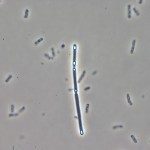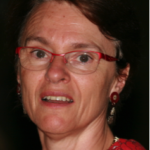Lien vers Pubmed [PMID] – 2117666
J. Mol. Biol. 1990 Aug;214(3):657-71
The levanase gene (sacC) of Bacillus subtilis is the distal gene of a fructose-inducible operon containing five genes. The complete nucleotide sequence of this operon was determined. The first four genes levD, levE, levF and levG encode polypeptides that are similar to proteins of the mannose phosphotransferase system of Escherichia coli. The levD and levE gene products are homologous to the N and C-terminal part of the enzyme IIIMan, respectively, whereas the levF and levG gene products have similarities with the enzymes IIMan. Surprisingly, the polypeptides encoded by the levD, levE, levF and levG genes are not involved in mannose uptake, but form a fructose phosphotransferase system in B. subtilis. This transport is dependent on the enzyme I of the phosphotransferase system (PTS) and is abolished by deletion of levF or levG and by mutations in either levD or levE. Four regulatory mutations (sacL) leading to constitutive expression of the lavanase operon were mapped using recombination experiments. Three of them were characterized at the molecular level and were located within levD and levE. The levD and levE gene products that form part of a fructose uptake PTS act as negative regulators of the operon. These two gene products may be involved in a PTS-mediated phosphorylation of a regulator, as in the bgl operon of E. coli.




